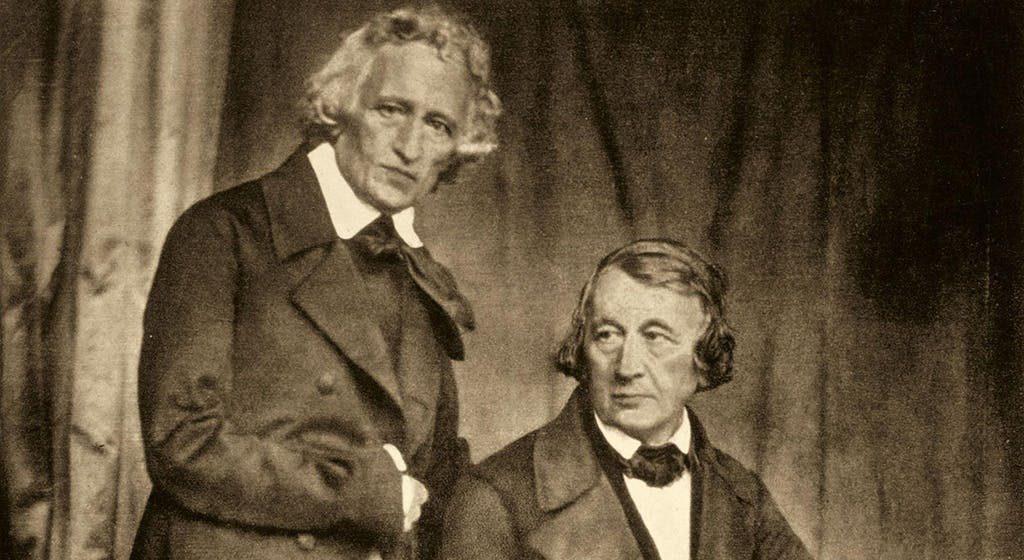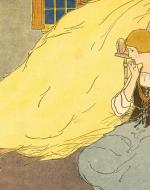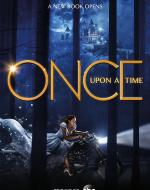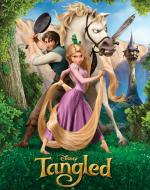Created by Rachel Schoenwald on Sun, 10/13/2024 - 12:50
Description:
The Grimm Brothers’ first collection, Children’s and Household Tales (Kinder- und Hausmärchen), published in 1812, stands as a formative work in the preservation of folk storytelling. Rather than inventing stories from scratch, the Grimms compiled narratives from friends and neighbors, capturing the essence of oral tradition while filling the tales with a poetic, at times moralistic, touch. Though often associated today with childhood innocence, these stories were originally intended for adults, brimming with dark themes, violence, and moral ambiguity that reflected the harsh realities and anxieties of their time. Over successive editions, the brothers adapted the tales, softening their more graphic elements and emphasizing clearer moral lessons, aligning them more with the sensibilities of children and family audiences. However, beneath these edits lay narratives designed more for entertainment than purely didactic purposes. With famous stories such as "Cinderella", "Snow White", "Hansel and Gretel", "Rumpelstiltskin", and Rapunzel, the collection captivated audiences through its vivid depictions of cruelty, supernatural forces, and the struggle for survival, revealing human foibles and society’s values. The Grimms’ work was groundbreaking not merely for preserving German folklore, but for establishing fairy tales as a vehicle for cultural expression and communal storytelling. Their legacy, further shaped by adaptations in literature and film including softened renditions by Disney, highlights how these stories have transcended their original purpose to teach to become enduring works of entertainment woven with moral complexity.
Wilhelm and Jacob Grimm, 1847, daguerreotype by Hermann Biow, Bavarian-studies.org. Jakob and Wilhelm Grimm, the eldest of six siblings, grew up in poverty after their father’s death. Next door to the Grimms in Cassel, Germany lived the Wild family, which included six daughters and a son. The Grimms began collecting folk tales during the French occupation under Napoleon, partly to earn money and partly in defiance. The Wild girls, specifically Dortchen, were key contributors; Dortchen provided nearly a quarter of the tales in their first collection, including "The Frog King", "Hansel and Gretel", "Six Swans", and "Rumpelstiltskin". Wilhelm and Dortchen fell in love, but their poverty delayed marriage until their book gained success. Initially criticized as too scholarly and explicit, the book as Wilhem revised it to appeal to a broader audience, adds phrases like “once upon a time” and “happily ever after.” Their younger brother Ludwig illustrated the first Children’s Edition in 1825, which became an international bestseller. Thirteen years after meeting, Wilhelm and Dortchen finally married and lived with Jakob happily until their deaths.
Arthur Rackham, "Hansel and Gretel and the Witch on the Doorstep of her Cottage," Grimm's Fairy Tales (1823), Jacob and Wilhelm Grimm, 1909 edition. The Grimm Brothers' "Hansel and Gretel" is one of the most famous and enduring fairy tales and was first published in 1812 in their collection Children's and Household Tales. The story follows two children, Hansel and Gretel, who are abandoned in the forest by their impoverished father and stepmother. Due to famine and extreme poverty, the stepmother persuades the father to abandon the children in the forest, as they can no longer feed them. Hansel attempts to leave a trail using breadcrumbs, but the birds eat them; the children are lost in the forest and cannot find their way back. Hansel and Gretel come upon a house made of bread, cake, and sugar. They begin to eat it, but an old woman emerges and invites them inside. Unbeknownst to them, she is a wicked witch who lures children to her house to fatten and eat them. She imprisons Hansel in a cage and forces Gretel to be her servant. The witch plans to eat Hansel after he is fattened up, but Hansel cleverly tricks her by offering her a bone instead of his finger to feel through the bars of the cage, making her think he is still too thin. Eventually, the witch grows impatient and orders Gretel to prepare the oven, intending to roast her as well. However, Gretel tricks the witch into checking the oven herself, shoves her in, and kills her. The children find the witch’s treasure and return home to their father, who has been abandoned by the stepmother; the family is now wealthy and live happily ever after. Rackman depicts the witch as an exaggerated and ugly old woman; the children look as they are almost staring at her in amazement, yet there is also a sort of helplessness to them. "Hansel and Gretel" showcases the importance of resourcefulness and familial bonds, but these narratives are woven into the fabric of an exciting, somewhat gruesome, tale rather than presented in a heavy-handed, moralistic fashion.
The Miller's Daughter Meets Rumplestilskin, Illustration by Margaret Evans Price, 1921, Fairy Tales, Bedtime Stories. In the Grimm Brothers' tale of "Rumpelstiltskin", a poor miller boasts to the king that his daughter can spin straw into gold. The king, intrigued by this claim, orders the daughter to prove her skill, locking her in a room full of straw and demanding that she spin it into gold or face death. The girl, terrified and helpless, is visited by a strange little man who offers to spin the straw into gold in exchange for her necklace. The next night, the king demands the same task, and again the little man helps her, this time taking her ring as payment. On the third night, the king promises to marry the girl if she spins another room full of straw into gold. The little man returns but demands that she promise her firstborn child if she becomes queen, and she agrees. After the task is completed, the king marries her, and she becomes queen. A year later, the queen has a child, and the little man returns to claim the baby. The queen, desperate to keep her child, begs for mercy. The man gives her three days to guess his name, or she must forfeit her baby. The queen sends a messenger to search for unusual names, and on the third day, the messenger overhears the little man singing about his name, Rumpelstiltskin. When the queen guesses correctly, the little man flies into a rage and tears himself in two. In Rumpelstiltskin, the focus leans more toward entertainment through suspense, magical elements, and vivid imagery, while any moral lessons are subtle and secondary to the narrative. The story's fantastical elements - like spinning straw into gold, the mysterious little man, and the king’s extravagant demands - create a sense of wonder and intrigue. Margaret Evans Price encapsulates this imagery of Rumplestilkin in the image above; he is depicted as a kind of mix of a dwarf, man, and goblin-like creature. The impossible task faced by the miller’s daughter and her reliance on a magical figure heighten the stakes, keeping the reader engaged. These narrative elements are designed to entertain by keeping the audience hooked through magical interventions, high stakes, and a surprising, dark conclusion.
Once Upon a Time (TV Series 2011–2018), IMDb. Once Upon a Time is a fantasy drama that reimagines classic fairy tale characters, blending their stories with real-world elements. Set primarily in the town of Storybrooke, Maine, the series follows Emma Swan, who learns she’s the daughter of Snow White and Prince Charming and is destined to break a curse cast by the Evil Queen. The curse transports fairy tale characters to the real world, erasing their memories of who they are. As Emma and her allies work to restore the characters’ memories and defeat various villains, the show explores themes of love, family, redemption, and the duality of good and evil. In Once Upon a Time, Rumpelstiltskin is a much more complex character than in the traditional fairy tale. Known as "The Dark One," he is imbued with dark magic that grants him immense power but also corrupts him. His backstory involves being a cowardly man who acquires this magic to protect his son, Baelfire, though his obsession with power eventually drives them apart. Throughout the series, Rumpelstiltskin struggles with his dual nature, oscillating between the villain and a redeemable antihero as he strives to reunite with Baelfire and later, to win the love of Belle. This portrayal departs from the original folktale, where Rumpelstiltskin is a one-dimensional villain who spins straw into gold in exchange for a child. The show transforms him into a tragic, morally ambiguous character, making his story about the consequences of power and the possibility of redemption. In the series, Hansel and Gretel appear in an early episode where they are separated from their father and captured by the Evil Queen. She forces them into a mission to retrieve an item from the Blind Witch’s gingerbread house. Hansel and Gretel manage to escape and reunite with their father, but in Storybrooke (where fairy tale characters live under the curse), their family remains separated, and they struggle to find each other again. This version of Hansel and Gretel’s story expands upon the themes of family separation and reunion and adds darker, more mature elements to the fairy tale, with a greater emphasis on the trauma and resilience of the children. In both cases, Once Upon a Time departs from the traditional fairy tales by giving its characters richer backstories and moral complexity, aligning them with the show's overarching themes of redemption, family, and the shades of good and evil in everyone.
Wanda Gag, “Rapunzel Lets Down Her Hair to the Enchantress, Grimm's Fairy Tales (1823), Jacob and Wilhelm Grimm, 1963 edition, PookPress.co.uk. The Grimm brothers’ story of "Rapunzel" begins with a couple who long for a child. When the wife craves rampion (rapunzel) from a forbidden garden owned by an enchantress, her husband risks sneaking in to retrieve it. Caught by the enchantress, he agrees to surrender their unborn child to her in exchange for the rampion. The enchantress names the girl Rapunzel and raises her in a secluded tower, only accessible by Rapunzel lowering her long hair out the window. One day, a prince hears her singing and climbs up, and they fall in love. They plan her escape, but the enchantress discovers their meetings, cuts off Rapunzel’s hair, and banishes her to a desert. When the prince tries to reunite with her, he encounters the enchantress, is blinded, and wanders until he eventually finds Rapunzel, whose tears restore his sight. They return to his kingdom and live happily. The story of Rapunzel focuses much more on dramatic elements and emotional engagement than on conveying a strict moral lesson. It involves magical punishment and reward, while captivating readers through suspense, romance, and the hardship the couple endures before their reunion. The conclusion delivers a satisfying, fairy-tale ending rather than a clear moral.
Disney's Tangled Movie Poster (2010), IMDb. In Disney's Tangled (2010), Rapunzel is a princess with magical, long hair that can heal wounds and grant youth. As a baby, she’s kidnapped by the evil Mother Gothel, who hides her away in a tower to exploit the hair’s powers. Eighteen years later, Rapunzel meets a thief, Flynn Rider, who becomes her reluctant guide on an adventure to see the floating lanterns that appear every year on her birthday. Through this journey, she discovers her true identity, falls in love, and eventually returns to her family after a dramatic battle with Gothel, who ultimately falls to her demise. Disney's version diverges from the Brothers Grimm tale in several major ways. In the original story of "Rapunzel", there are no floating lanterns, magic hair, or complex character identities; Disney transforms this story into a more lighthearted and relatable one for its audience. In the Grimm brothers tale, Rapunzel’s prince is simply that - a prince. Disney reimagines him as Flynn Rider, a witty and charming thief who ultimately finds redemption through his love for Rapunzel. Additionally, Disney often includes animal companions, and Tangled is no exception; Pascal the chameleon and Maximus the horse provide comedic relief and add entertainment for both characters and audiences. They also are displayed on the movie poster right alongside Rapunzel and Flynn Rider. These animals add new themes of loyalty and friendship to the story, resonating with Disney’s audience. While Dame Gothel is a central figure in the Grimm story, Disney’s version makes her a more psychologically complex and overtly evil villain. She manipulates Rapunzel by pretending to be a loving, protective mother, while in reality, she is entirely self-serving. This version of Gothel emphasizes themes of control and emotional abuse, giving Rapunzel’s escape a stronger sense of personal liberation. In Tangled, Rapunzel’s journey centers on discovering who she truly is beyond the confines of her tower. This coming-of-age theme is not a central focus in the Grimm version, where Rapunzel’s main storyline is focused on romantic love and motherhood. Disney’s emphasis on independence and finding one’s own path speaks more directly to modern audiences and aligns with Disney’s broader themes of individual growth and self-discovery. While the original Grimm brothers’ story of "Rapunzel" is entertaining and captivating, Disney’s Tangled adds greater dimension and depth to the characters.







